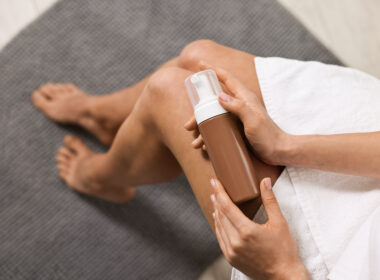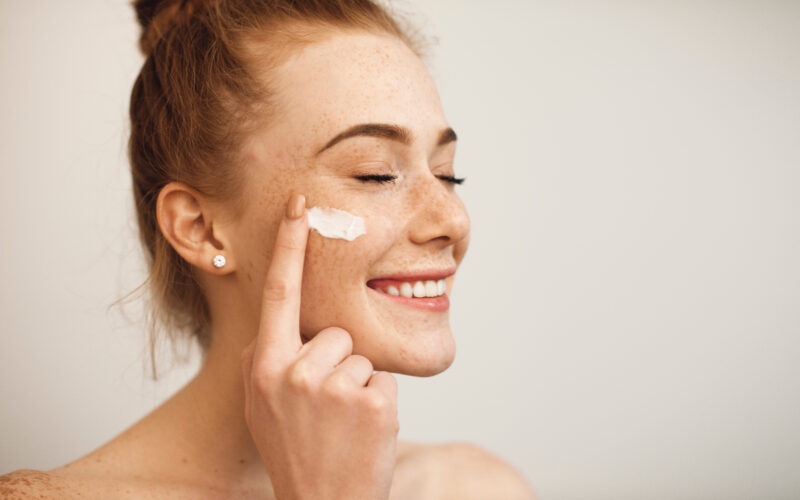First coined by female hormone expert Alisa Vitti in her 2014 book WomanCode, and then described in detail in her 2021 book In The FLO, the term “cycle syncing” refers to working with (not against!) your body’s natural hormonal patterns to improve your personal life, career, and fitness levels.
According to TikTok influencers, cycle syncing can even be used to fight acne and attain clearer, brighter skin. But a recent Cosmopolitan article about cycle syncing to manage acne missed the mark. The author, Charlotte, says she benefits from this practice and gives detailed information on cycle phases, hormonal changes, and products to use, but the article also notes that she is on hormonal birth control. Let’s “clear up” any confusion on why cycle syncing and hormonal birth control can’t coexist, and shine a light on how to harness your cyclical hormonal changes for your brightest, healthiest skin.
What does it mean to cycle sync your skincare?
Cycle syncing is the process of understanding the hormonal changes and their observable biomarkers (like temperature rise, cervical mucus changes, and urinary hormone changes) throughout your menstrual cycle, and tailoring your daily habits according to the phase you are in. When it comes to cycle syncing your skincare specifically, the goal is to recognize how your skin’s needs may change as your hormones fluctuate in each cycle phase, and to adjust your practices accordingly. This may help you to not just avoid acne but also improve your complexion, including taking advantage of when your skin is most likely to glow!
Why can’t women on hormonal birth control cycle sync their skincare?
Recall that your cycle consists of two main phases: the first part of the cycle is your follicular phase, (just remember “the follicle comes first”), starting with menstruation and continuing through ovulation. The second part of your cycle is the luteal phase, beginning right after ovulation and continuing through the last day before your next period starts. Your estrogen and progesterone levels change in distinct, consistent ways during each of these phases. Some sources, like the one below, distinguish between four cycle phases: menstrual, follicular, ovulatory, and luteal.
Ovulation, not your period, is the main event of the whole cycle. You can only truly practice cycle syncing, then, when you are experiencing ovulatory cycles. But the whole point of hormonal contraception is to prevent ovulation. Women on hormonal birth control are not experiencing true cycles because they’re not ovulating. You can’t cycle sync if you don’t have a cycle! Cosmopolitan missed this key fact in its writeup on cycle syncing skincare.
You can’t cycle sync if you don’t have a cycle! Cosmopolitan missed this key fact in its writeup on cycle syncing skincare.
How to cycle sync your skincare by cycle phase
The first step to cycle syncing your skincare is to have regular cycles and utilize a Fertility Awareness Method (FAM) of cycle charting. Even though some of the following tips could be helpful for women experiencing acne on the Pill, as demonstrated in the Cosmopolitan article, cycle syncing aims to utilize the knowledge of our natural hormonal fluctuations to help us live our lives to the fullest. If you are not experiencing these natural hormonal fluctuations due to timed synthetic hormone release from hormonal contraception, you won’t reap the full benefits of cycle syncing.
Estrogen and progesterone levels impact your skin
Though we typically think of estrogen and progesterone as impacting the ovaries and uterus, their rise and fall can impact acne, psoriasis, atopic eczema, and irritant dermatitis, according to research [1]. But how? According to Dr. Dennis Gross, a dermatologist and cancer researcher whose skincare line is sold by Sephora and searched 33,000+ times/month, estrogen is a proliferating hormone. This means it hydrates, plumps, and increases collagen production in the skin. Progesterone increases circulation and oil production in the skin.
Hormonal deficiency during various parts of the cycle can increase acne, and in fact there’s a connection between irregular cycles (which may be caused by hormonal problems) and skin problems [2]. Understanding where you are in your cycle and how healthy your hormones are can help you tailor your skincare to address your skin’s needs and avoid breakouts.
Your cycle is broken into four main phases: menstruation, follicular, ovulatory, and luteal phases. Each phase is defined by specific hormone production and thus requires a unique skincare regime.
Menstruation
Menstruation is the first phase, marking the beginning of a new cycle. During this phase, the uterine lining sheds as a result of the fall of progesterone and estrogen at the end of the luteal phase. Think of this as a time of restoration and healing.
Dr. Gross recommends using products such as hydrating masks, serums, and moisturizers to help moisturize and repair your skin after the more acne-prone luteal phase. Product ingredients to look for include niacinamide, hyaluronic acid, peptides, and ceramides.
Follicular Phase
The follicular phase is defined by the growth and maturation of a follicle as it prepares for ovulation. Estrogen is rapidly rising during this phase. This means your skin will benefit from an increase in collagen and hydration levels. Often, this is a healthier phase for your skin. You may even feel like it is glowing. Despite the lack of skin blemishes in this phase, skincare is still important to avoid breakouts later.
The recommended skincare regime, according to Dr. Gross, is focused on maintenance during this time. Look for products that contain ingredients like retinol, bakuchiol, ferulic acid, and rambutan. Additionally, according to Dr. Mindy Pelz, chiropractor and author of The Menopause Reset and Fast Like a Girl, hyaluronic acid and vitamin C serum can enhance your skin’s natural glow. These ingredients promote natural hydration and collagen production while controlling any excess oil from balancing progesterone levels.
Ovulatory phase
The ovulatory phase is characterized by peak estrogen levels and ovulation, the act of the mature follicle releasing the egg into the fallopian tubes. These peak levels of estrogen continue to enhance the glowing effect from the follicular phase. Testosterone is also high during this phase which causes an initial increase in oil production. Once ovulation occurs, progesterone levels begin to rise as estrogen decreases, further enhancing the skin’s oil production.
Skincare in the ovulatory phase should be focused on prevention as you head into the luteal phase, the most acne-prone phase of your cycle. According to Dr. Gross, you should focus on oil-free moisturizing products and exfoliants during this time. A lightweight lotion can also be used for hydrating the skin.
Luteal phase
The luteal phase is defined by the life of the corpus luteum, formed by the follicle after ovulation. During this phase, progesterone is the dominant hormone produced by the corpus luteum. Oil production increases with the rise of progesterone. As Cosmo noted, cortisol also rises in the luteal phase. This can intensify blemishes, sensitivity, and clogged pores on the skin.
During the luteal phase, more than any other time, breakouts tend to be more common. This is when consistency in your daily skincare routine is most important. Your focus should be on eliminating excess oils and unclogging your pores. Dr. Gross recommends using non-comedogenic products with ingredients like colloidal sulfur, kaolin clay, and bentonite clay. Some exfoliation, spot treatment, and Niacinamide, a form of Vitamin B, may be effective for your luteal phase face care.
What’s the connection between hormonal birth control and acne?
Many teenage girls are prescribed birth control to help manage their acne. This can be an effective solution because synthetic estrogen lowers androgen levels and thus decreases acne. Of course, less acne may not be a fair trade for increased risk of benign liver tumors, mental health problems, breast cancer, cervical cancer, blood clots, stroke, gallbladder problems and autoimmune issues.
What’s more, not all forms of hormonal birth control have this anti-androgenic effect. For instance, progestin-only birth control does not contain synthetic estrogen. This can result in an increase in acne problems. This was the experience of Charlotte Bitmead, the author of the recent Cosmopolitan article, which inspired her to explore cycle syncing her skincare.
Why did my acne return after coming off the Pill?
Many women experience acne coming off the Pill. This could be a temporary reaction from a rise in androgens as your hormones work to return to normal, or it could be because you no longer have the hormonal withdrawal caused by the synthetic hormones to mask your acne symptoms. It is also important to note that birth control, according to Dr. Jolene Brighten (author of Beyond the Pill and Is This Normal?), depletes the body of essential nutrients like zinc, so post-Pill acne could be a result of nutrient deficiency.
How can I manage my acne without the Pill?
If you used birth control to manage your acne in the past but are working to manage it without the Pill, there are effective steps you can take to heal your skin. According to Dr. Brighten, starting with appropriate supplementation, a nutrient-rich diet, stress management, and natural beauty products can effectively defend your skin against blemishes. Once you have addressed these four daily habits, charting your cycle and practicing cycle syncing can help you get to the root causes of your breakouts.
The 28 app could be another great tool to help you with cycle syncing your skincare. This app was designed to help you center your habits around your cycle. Keep in mind that the algorithm follows the rhythm method, so it cannot be tailored to recognize your unique cycle phases. Don’t use 28 for family planning.
The bottom line on cycle syncing your skincare
Cycle syncing your skincare, when done properly with cycle charting to understand what cycle phase you are in, has the potential to transform your skincare routine. You may even find answers for why you are experiencing acne and be able to get to the root hormonal cause. Practically, we recognize that the woman’s body changes daily. It makes sense that our hygiene practices should follow those changes.
Additional Reading:
Cycle Syncing: How to hack the natural hormonal shifts of your menstrual cycle
Worried about acne returning after getting off the Pill? Read this
Cause or cure? Why birth control isn’t the best solution for teen acne
How to get rid of acne without the Pill
References:
[1] R. S. Raghunath, Z. C. Venables, G. W. M. Millington, The menstrual cycle and the skin, Clinical and Experimental Dermatology, Volume 40, Issue 2, 1 March 2015, Pages 111–115, https://doi.org/10.1111/ced.12588 [2] Ma L, Jiang H, Han T, Shi Y, Wang M, Jiang S, Yang S, Yao L, Jia Q, Shao L. The menstrual cycle regularity and skin: irregular menstrual cycle affects skin physiological properties and skin bacterial microbiome in urban Chinese women. BMC Womens Health. 2023 May 31;23(1):292. doi: 10.1186/s12905-023-02395-z. PMID: 37259058; PMCID: PMC10230734.







This blog provides a very insightful perspective on cycle syncing for skincare. I appreciate the detailed breakdown of how hormonal fluctuations affect our skin and how we can adapt our routines for each cycle phase. It’s also refreshing to see a clear explanation of why this method may not be applicable to those on hormonal birth control. Overall, the article does an excellent job of empowering women to work with their natural hormonal patterns rather than against them.